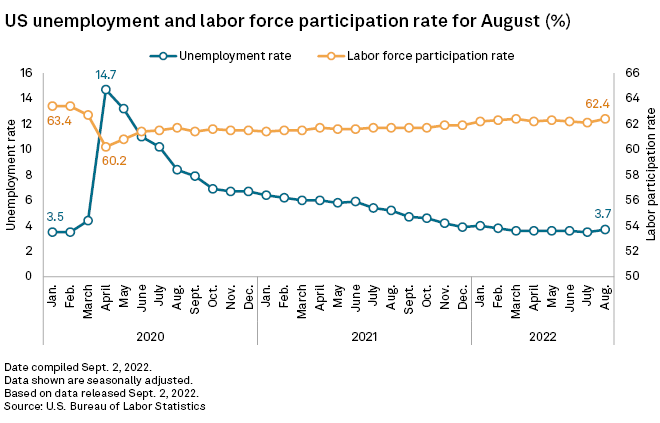With investors on edge about a tightening monetary policy, the U.S. job market once again strengthened in August suggesting the Federal Reserve will continue its aggressive attempts to rein in inflation.
Unemployment ticked up as 786,000 more people joined the labor force and job growth moderated in August, the U.S. Bureau of Labor Statistics reported Sept. 2.
The numbers indicate a jobs market still growing robustly while showing signs some labor market tightness is letting up. Nonfarm payrolls rose by 315,000 in August, well above the consensus estimate of 293,000, according to Econoday. The business services, healthcare and retail trade sectors were among the top drivers of job growth.
Fewer jobs were added in August than in July, and the labor force participation rate rose. The cooler growth suggests the Fed's efforts to slow the economy are succeeding, but the fight against inflation is far from over.
"The Fed still has a lot of work to do," Rubeela Farooqi, the chief U.S. economist at High Frequency Economics, said in an interview.

The unemployment rate rose to 3.7% in August, up from 3.5% in July. The labor force participation rate — the number of potential workers in the overall population who are in the job market — rose to 62.4%, up from 62.1% in July, and 1 percentage point below its pre-pandemic level in February 2020.
"People coming back into the labor force, which takes the pressure off wages — I think that's an important development," Farooqi said.
Average hourly earnings rose to $32.36, up 0.3% from July and slower than the previous monthly increase of 0.47%.
Jobless claims
Jobless claims for the week ending Aug. 27 fell to 232,000, down 5,000 from the previous week and below the consensus estimate of 246,000, according to Econoday.

"The stronger than forecast jobless claims suggest that economic slowdown concerns still haven't reached the labor market," Fiona Cincotta, a senior financial markets analyst at City Index, said in an email.
Further rate increases expected
The strong rise in the labor force participation rate pushed up unemployment and is a positive sign that people are responding to strong demand for labor, Emily Crowley, an associate director of economics at S&P Global Market Intelligence, said in an interview.
"We have been struggling to get that labor force participation rate higher," Crowley said.

As the Fed raises interest rates to lower inflation, it is watching to see whether its actions damage the labor market. With job growth strong there is little evidence the labor market is suffering as a result of the Fed's actions, and rising wages support further rate increases, Crowley said.
"So far it doesn't look like any damage is being done to labor markets while they pursue this aggressive path of interest rate increases to contain inflation," Crowley said.
Most traders believe that the rate-setting Federal Open Market Committee will announce another 75-basis-point raise to benchmark interest rates at its September meeting, according to the CME FedWatch Tool, which measures investor sentiment in the Fed funds futures market. Still, the odds of a 50-bps hike rose above 40% on Sept. 2 from 25% a day earlier, reflecting a growing belief that the Fed will take its foot off the gas.
"The August employment report contains enough good news for the Fed that will lead them to slow the pace of rate hikes beginning in September," economists with BofA Global Research said in a Sept. 2 report.



